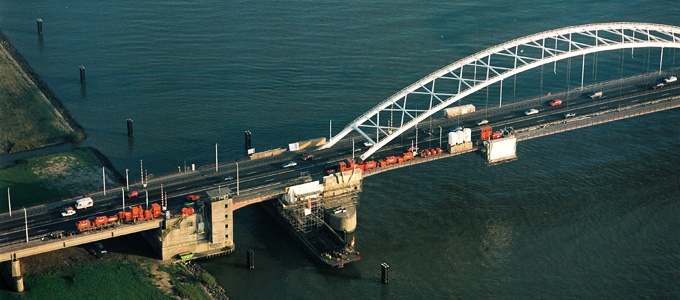Bridge cleaned with new gritblasting technique
GORINCHEM – Part of the bridge over the Boven Merwede river at Gorinchem is being treated with a new gritblasting technique which causes less damage to the environment. Van der Ende Straal- en Schilderwerken from Hoogvliet has recently started using a new, mobile grit recycling installation, which produces much less waste than the conventional gritblasting method. It is the first time that this technique has been used on a Dutch bridge. The Dutch Department of Public Works is having the Merwede bridge preserved to keep it in perfect condition for the next 15 to 20 years. The construction will be cleaned and given a new layer of paint, so that dirt and weather cannot affect the steel frame.
Blown With the conventional gritblasting method, the layer of paint is removed with a slag grit. The slag grit, a finely ground waste product from the steel industry, is blown against the bridge under high pressure in an enclosed space. The grit is then sucked up and transported in a sealed lorry to a special processing company.
The recycling installation of Van der Ende uses a different type of grit. “This steel grit, which consists of pieces of strong, sharp-edged steel, lasts longer than slag grit”, says commercial manager P. van der Ende.
Depending on the object to be gritblasted, it can be used up to two or three hundred times. It is the first time that we have used this installation, which originates from the United States, on a bridge. Companies in America were forced to develop the installation, which processes the used grit, as a result of the very high waste processing costs. The installation costs more than NLG 1,000,000, but, according to Van der Ende, the investment will definitely pay for itself. With this new technique, we will produce approximately 2,500 kg of waste after gritblasting the bridge, whilst in the old situation, we would have produced approximately 50,000 kg of waste. In the installation, the waste is separated into large waste, such as glass, pieces of work gloves, dust and paint. Everything is collected in sealed containers. The grit is magnetically filtered, after which it is ready for use again.








